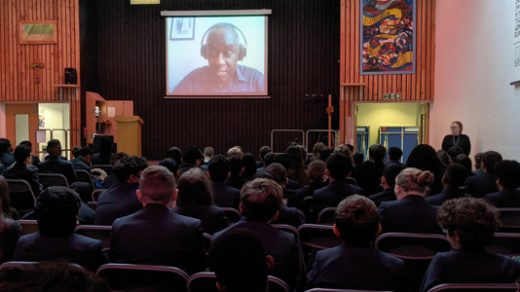Keep calm and carry on – communicating in a crisis

School leaders have risen to many challenges during the COVID-19 pandemic – from social distancing, remote learning and ensuring the most vulnerable are protected. Underlining all these challenges is the need for clear and effective communication, ensuring that pupils, parents and other key stakeholders know what is happening at the school. Educate takes a look at how primary schools have kept calm and carried on by strengthening communication, transparency and trust.
The COVID-19 pandemic has led to 191 countries closing their schools, colleges and other institutes to the majority of pupils and students, leaving 1.5 billion children unable to attend school physically. When we first learnt about the virus, there was a lot of misconceptions, concerns and fears, which were only heightened by social media and numerous press outlets. When schools shut their gates in March 2020 to all but vulnerable children and the children of key workers, there seemed to be no clear plan of what was expected of schools, but one thing was for certain – communication would need to be accessible, timely and encouraging to mitigate the high levels of uncertainty.
Over the last couple of years, primary schools have increasingly adopted a comprehensive range of strategies to communicate with pupils, parents and their communities. This year, the pandemic has pulled communication into sharp focus and the need for a two-way dialogue between schools and their families has never been greater.
A 2011 government review investigated the best practices of parental engagement and research found that children perform better when parents are involved in their schooling. It also placed an emphasis on schools that ‘engage the community and build strong links with parents’ had sustained school improvement.
One key tool schools often utilize is their website, which can act as a hub of information for parents and carers. Bickerstaffe Primary School near Ormskirk has a dedicated COVID-19 page on its website, with links to online safety policies, risk assessments and remote learning contingencies. Redgate Primary School in Liverpool collated a series of home learning packs to support pupils who are isolating or off sick. The resources can all be downloaded online or parents have the option to contact the school for paper copies.
Digital platforms and online tools have arguably become the most common communication method schools use, even before the pandemic. Research by the Office for National Statistics (ONS) found that in January 2020, 96% of households in Great Britain had internet access, up from 57% in 2006. Social media channels, such as Twitter or Facebook, are key platforms to send out announcements, last minute reminders and can unite school communities. Faith Primary School in Everton uses its Twitter account to share important information for parents/carers and to highlight its new ways of working, such as whole school assemblies over Zoom and virtual coffee mornings with parents.
With busy family life constantly evolving, one positive of the pandemic has been the adaptability of schools to introduce new communication methods to respond to the rapidly changing situation.
From online parents’ evenings to one-to-one video calls, our technology-rich world has made it even easier to make communication stronger.
While Twitter and other social media channels can be effective for one-way communication, twoway communication is important to engage parents, carers and pupils in a conversation and give them the opportunity to offer feedback, ask questions and speak to teaching staff directly.
ClassDojo is a free app which allows communication between teachers, students and families. Users can share what is being learnt in the classroom home through photos, videos and messages. According to the US company, it has been used by 70% of schools in the UK, as of 2018. The app is used to encourage good behaviour and to communicate with parents, as teachers can upload photographs and videos on to the platform such as awards presentations and examples of pupils’ work.
During the last 12 months, ClassDojo has also been used as a remote home learning tool to set tasks for pupils and provide a much-needed link between teachers, pupils and their families.
Liscard Primary School in Wirral lists ClassDojo as one of its main communication tools, alongside email, face-to-face meetings, letters and the school website. Its communication protocol clearly states how it will communicate with families, how parents can raise any concerns and its code of conduct for all communications.
Google Classroom, Microsoft Teams and Zoom are all other platforms which are now regularly used to create online classrooms for home schooling. While all schools across the country once again closed to all but vulnerable children and the
Children of key workers, 2021 has seen a return of a full national lockdown, which is set to continue until after the February half-term. Online learning portals, such as Google Classroom offer schools some stability and a means of keeping communication strong. St Nicholas’ Catholic Primary School in Liverpool uses Google Classroom to set weekly homework and ensure pupils can continue their learning during any lockdown measures or COVID-19 outbreak which requires children or whole class bubbles to isolate. On its website, it has instructions on how to use the app, handy how-to videos for parents to view and even has a dedicated contact form for Google Classroom help.
The rise of online learning between teachers and pupils has raised important questions about safeguarding and GDPR policies. While schools want to get information out as quickly as possible, especially when guidance can be updated daily, schools should always remember to use their approved communication channels in line with their safeguarding/ GDPR/home working policies.
It’s also important to understand and review any third-party privacy notices if you are using their platform to stream or record live lessons. The government issued guidance in April calling for schools, teachers and pupils to maintain professional practice as much as possible. It stated that when communicating online, schools should use school email accounts (not personal ones), communicate via approved school channels and use school devices over personal devices where possible.
Another popular communications app, specifically targeted at parents is ParentMail. Essentially, the app connects parents to their child’s school, with the aim to make essential communications much simpler. Schools can choose services such as text, online payments, messaging, parents’ evening manager and online form collections such as dinner money, parental consent and online surveys.
The app makes it easy for parents to access everything they need in once place, and for schools, it helps them build meaningful relationships with parents which can influence the success of its pupils. The app also says its ‘socially inclusive’ and accommodates those who don’t have a smartphone or computer or prefer traditional ways of communication.
While 96% of households in Great Britain have internet access, what about the 4% without? Using digital platforms alone could be alienating families who don’t have broadband or the equipment to stay up to date. Ensuring school communication is accessible and inclusive for all is key. Promoting access to paper copies of letters, newsletters and homework is a good way to ensure all families can access timely information. Personal phone calls, particularly to those parents whose responses have been scarce through other means, could help start a conversation with those hardest to reach.
While external communication with families is vital, it’s important that internally, communication is strong and clear, so everyone from senior leaders to classroom teachers understand the latest news, policies and updates.
A survey conducted by Teacher Tapp before the schools reopened in September, found that 62% of classroom teachers were the most nervous about the return of face-to-face teaching. Internal communications are critical to the strength, direction and morale of staff, particularly this year. This could be as simple as holding virtual meetings to communicate key updates to staff, setting up a WhatsApp group with senior management to discuss information or sending email bulletins with key headlines. With teachers’ workloads as hectic as ever, it’s important that any communication is easy to access with clear calls to action.
Even before the pandemic, schools have had to adapt an increasingly comprehensive range of strategies to communicate with parents, carers and the wider community. In the world we now live in, it’s becoming more and more important for schools to develop valuable two-way dialogue between teachers and parents. The teachers, school leaders and support staff on the frontline during this pandemic have proven that in the face of many challenges, schools continue to go above and beyond to put pupils first.





